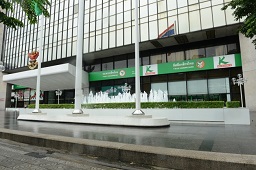The Bank is being committed to environmental awareness and to developing procedures, products and services that satisfy the customer needs while contributing to environmental preservation. Our commitment is made concrete in many ways, from Green Buildings for the Environment - the Chaeng Watthana, Phahon Yothin and Rat Burana Buildings, to KASIKORNTHAI Learning Center. Our green buildings have been based on the “Energy and Environmental Preservation” guidelines.
Fully recognizing that a safe, clean, and pleasant environment promotes employee effectiveness and facilitates contact with customers and the general public, KBank has implemented occupational safety, health and environmental measures in conformity with standards issued by the Ministry of Labor and consistent with recognized international standards.
Utilities within buildings are installed and operated with the health of staff as a primary concern. Examples include two-stage air filtration systems, eliminating inside air pollution; lighting at standard brightness comfortable for the eyes; and ozone drinking-water purification systems. Energy-efficient electrical appliances are used.
For a better environment in the surrounding community, the Bank has installed exhaust filtering systems limiting smoke, smell and noise. Highly efficient wastewater systems not only treat wastewater before it flows into the rivers, but also redirect treated wastewater for watering gardens and for use in cooling systems. Besides conserving energy, these systems help to preserve the environment.
KASIKORNTHAI Learning Center
As part of our energy saving and environmental preservation concept that has been continually implemented, KASIKORNTHAI Learning Center - a six-story building on a 7-rai plot of land in Bang Pakong District, Chachoengsao, with a 5,000-meter usable area - has been designed as a green building. The center is the first project in Thailand that has been granted the Platinum award in the category of New Construction, representing the highest standard of LEED (Leadership in Energy and Environment Design) by the U.S. Green Building Council or USGBC. The design and construction were aligned with the following guidelines:
- Use of viable technologies and design, of reasonable cost and suited to Thailand’s conditions.
- Sustainable design so that the project always remains a green building, via reduction of energy use by 30 percent, water use by 60 percent and construction debris by 80 percent, no wastewater disposal and full use of rainwater. There is also a management system aimed at using the building for the maximum benefit. It is hoped that, with all these features, the building may serve as a prototype for the green building industry in the future.
- Focus on the most efficient use of construction budget. Total budget was 245 million Baht, plus an additional fund for LEED implementation amounting to 8.4 million Baht, or 3 percent of total construction costs, which is minimal relative to the higher efficiency. Domestic materials were used, as well as the responsible team members and consultants, who are all Thais.
The building is on an open landscape to promote the value of the ecological system and quality of life of the people inside. To reduce the use of personal vehicles, a shuttle bus system is available for local and Bangkok staff, as well as other visitors. An integrated, low-cost system for sustainable water management includes wastewater, rainwater and water for landscape use, while highly efficient sanitary wares are used, which can reduce total water consumption by 58 percent.
During construction, measures were put in place to control waste disposal and thus produce the smallest-possible environmental impact. By means of waste recycling and management, the project’s waste debris was reduced by 80 percent. Environmental-friendly materials were chosen, and great consideration was placed on the interior environment, such as an air-conditioning system with appropriate temperature and humidity. All rooms can enjoy natural light and outside views to keep the people inside close to nature.
Head Offices at Rat Burana, Chaeng Watthana - Prototypes of Green Buildings
The two head offices have been praised as organizational concepts to promote green architectural knowledge in saving energy and being friendly to the environment. Construction has been done under LEED - the Green Building rating system by USGBC, the environmental organization that promotes and offers information about sustainability in how buildings are designed, built, and operated. The buildings also followed the Thailand Energy & Environmental Assessment Method (TEEAM) in assessing energy saving and eco-friendliness.
Transforming the Phahon Yothin Head Office into a Green Building
Recognizing the global energy and environmental crises, the Bank renovated the Phahon Yothin Building, home to KBank offices for over 25 years, as a green building. The renovation was motivated by the desire to elevate the quality of life of those working in the building and by the fact that existing, older-technology, infrastructure from electrical systems to air conditioning, consumed more energy than necessary. The Bank redid interiors throughout the building and completely retooled the water systems while leaving the external structure and main infrastructure intact. Inner walls were improved for modern, simple, and efficient functionality with open-plan office designs for smoother workflow and giving all workers access to external views and natural light. The building has earned LEED Gold certification. In 2011, the building was awarded Carbon Reduction Certification for Buildings by the Thailand Business Council for Sustainable Development (TBCSD) and the Thai Environment Institute (TEI), to promote efforts to reduce greenhouse gas emissions from commercial buildings.
